Lars Petersson
3D Gaussian Representations with Motion Trajectory Field for Dynamic Scene Reconstruction
Aug 10, 2025Abstract:This paper addresses the challenge of novel-view synthesis and motion reconstruction of dynamic scenes from monocular video, which is critical for many robotic applications. Although Neural Radiance Fields (NeRF) and 3D Gaussian Splatting (3DGS) have demonstrated remarkable success in rendering static scenes, extending them to reconstruct dynamic scenes remains challenging. In this work, we introduce a novel approach that combines 3DGS with a motion trajectory field, enabling precise handling of complex object motions and achieving physically plausible motion trajectories. By decoupling dynamic objects from static background, our method compactly optimizes the motion trajectory field. The approach incorporates time-invariant motion coefficients and shared motion trajectory bases to capture intricate motion patterns while minimizing optimization complexity. Extensive experiments demonstrate that our approach achieves state-of-the-art results in both novel-view synthesis and motion trajectory recovery from monocular video, advancing the capabilities of dynamic scene reconstruction.
GS-2DGS: Geometrically Supervised 2DGS for Reflective Object Reconstruction
Jun 16, 2025Abstract:3D modeling of highly reflective objects remains challenging due to strong view-dependent appearances. While previous SDF-based methods can recover high-quality meshes, they are often time-consuming and tend to produce over-smoothed surfaces. In contrast, 3D Gaussian Splatting (3DGS) offers the advantage of high speed and detailed real-time rendering, but extracting surfaces from the Gaussians can be noisy due to the lack of geometric constraints. To bridge the gap between these approaches, we propose a novel reconstruction method called GS-2DGS for reflective objects based on 2D Gaussian Splatting (2DGS). Our approach combines the rapid rendering capabilities of Gaussian Splatting with additional geometric information from foundation models. Experimental results on synthetic and real datasets demonstrate that our method significantly outperforms Gaussian-based techniques in terms of reconstruction and relighting and achieves performance comparable to SDF-based methods while being an order of magnitude faster. Code is available at https://github.com/hirotong/GS2DGS
MoKD: Multi-Task Optimization for Knowledge Distillation
May 13, 2025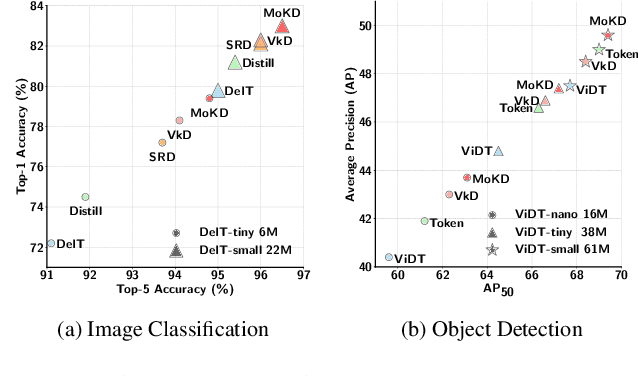
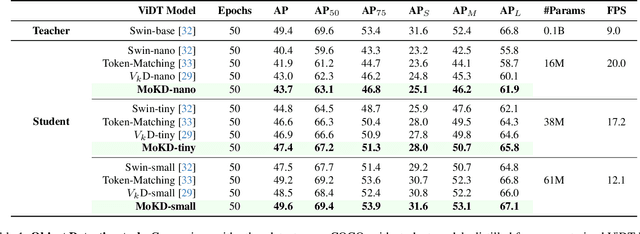
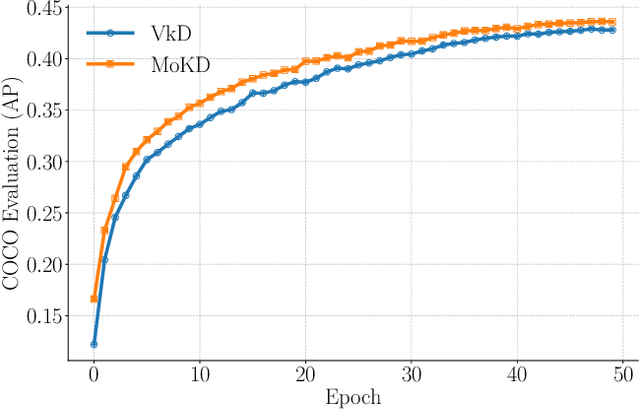
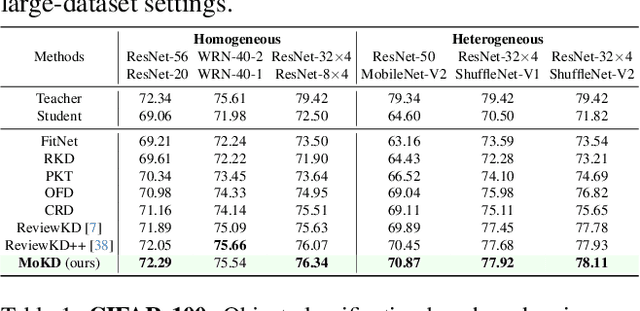
Abstract:Compact models can be effectively trained through Knowledge Distillation (KD), a technique that transfers knowledge from larger, high-performing teacher models. Two key challenges in Knowledge Distillation (KD) are: 1) balancing learning from the teacher's guidance and the task objective, and 2) handling the disparity in knowledge representation between teacher and student models. To address these, we propose Multi-Task Optimization for Knowledge Distillation (MoKD). MoKD tackles two main gradient issues: a) Gradient Conflicts, where task-specific and distillation gradients are misaligned, and b) Gradient Dominance, where one objective's gradient dominates, causing imbalance. MoKD reformulates KD as a multi-objective optimization problem, enabling better balance between objectives. Additionally, it introduces a subspace learning framework to project feature representations into a high-dimensional space, improving knowledge transfer. Our MoKD is demonstrated to outperform existing methods through extensive experiments on image classification using the ImageNet-1K dataset and object detection using the COCO dataset, achieving state-of-the-art performance with greater efficiency. To the best of our knowledge, MoKD models also achieve state-of-the-art performance compared to models trained from scratch.
Open Set Label Shift with Test Time Out-of-Distribution Reference
May 09, 2025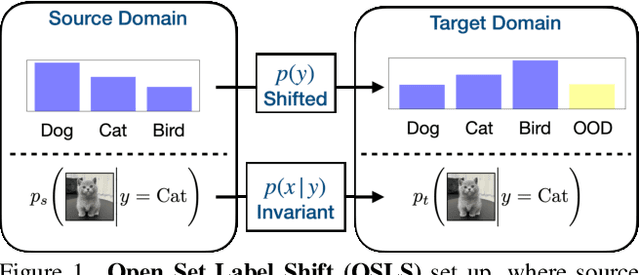
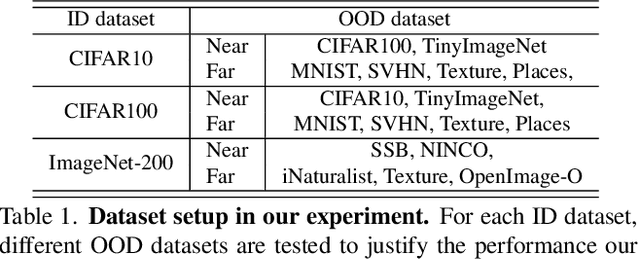


Abstract:Open set label shift (OSLS) occurs when label distributions change from a source to a target distribution, and the target distribution has an additional out-of-distribution (OOD) class. In this work, we build estimators for both source and target open set label distributions using a source domain in-distribution (ID) classifier and an ID/OOD classifier. With reasonable assumptions on the ID/OOD classifier, the estimators are assembled into a sequence of three stages: 1) an estimate of the source label distribution of the OOD class, 2) an EM algorithm for Maximum Likelihood estimates (MLE) of the target label distribution, and 3) an estimate of the target label distribution of OOD class under relaxed assumptions on the OOD classifier. The sampling errors of estimates in 1) and 3) are quantified with a concentration inequality. The estimation result allows us to correct the ID classifier trained on the source distribution to the target distribution without retraining. Experiments on a variety of open set label shift settings demonstrate the effectiveness of our model. Our code is available at https://github.com/ChangkunYe/OpenSetLabelShift.
Learning from Noisy Labels with Contrastive Co-Transformer
Mar 04, 2025



Abstract:Deep learning with noisy labels is an interesting challenge in weakly supervised learning. Despite their significant learning capacity, CNNs have a tendency to overfit in the presence of samples with noisy labels. Alleviating this issue, the well known Co-Training framework is used as a fundamental basis for our work. In this paper, we introduce a Contrastive Co-Transformer framework, which is simple and fast, yet able to improve the performance by a large margin compared to the state-of-the-art approaches. We argue the robustness of transformers when dealing with label noise. Our Contrastive Co-Transformer approach is able to utilize all samples in the dataset, irrespective of whether they are clean or noisy. Transformers are trained by a combination of contrastive loss and classification loss. Extensive experimental results on corrupted data from six standard benchmark datasets including Clothing1M, demonstrate that our Contrastive Co-Transformer is superior to existing state-of-the-art methods.
DGNS: Deformable Gaussian Splatting and Dynamic Neural Surface for Monocular Dynamic 3D Reconstruction
Dec 05, 2024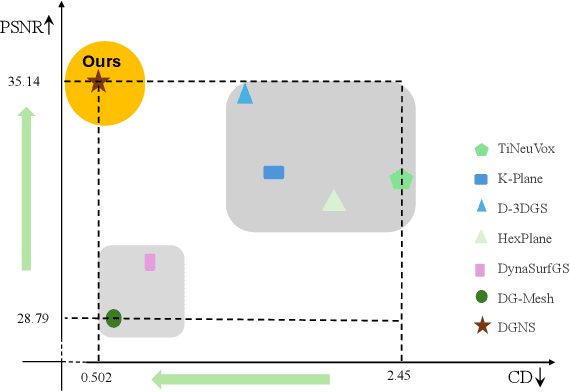
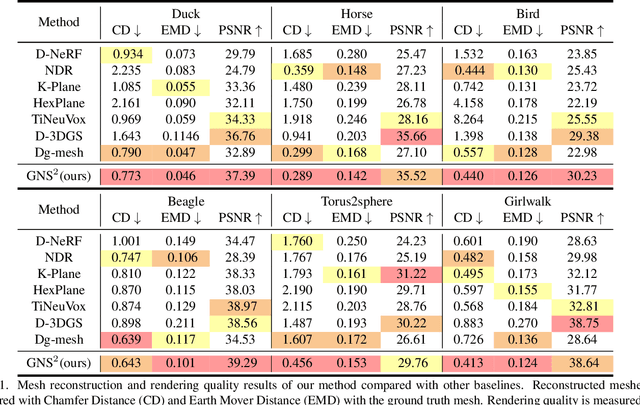

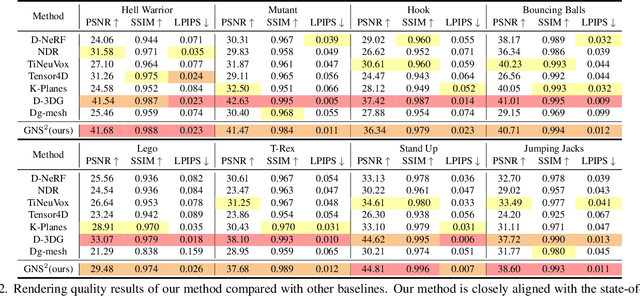
Abstract:Dynamic scene reconstruction from monocular video is critical for real-world applications. This paper tackles the dual challenges of dynamic novel-view synthesis and 3D geometry reconstruction by introducing a hybrid framework: Deformable Gaussian Splatting and Dynamic Neural Surfaces (DGNS), in which both modules can leverage each other for both tasks. During training, depth maps generated by the deformable Gaussian splatting module guide the ray sampling for faster processing and provide depth supervision within the dynamic neural surface module to improve geometry reconstruction. Simultaneously, the dynamic neural surface directs the distribution of Gaussian primitives around the surface, enhancing rendering quality. To further refine depth supervision, we introduce a depth-filtering process on depth maps derived from Gaussian rasterization. Extensive experiments on public datasets demonstrate that DGNS achieves state-of-the-art performance in both novel-view synthesis and 3D reconstruction.
Facial Expression Recognition with Controlled Privacy Preservation and Feature Compensation
Dec 03, 2024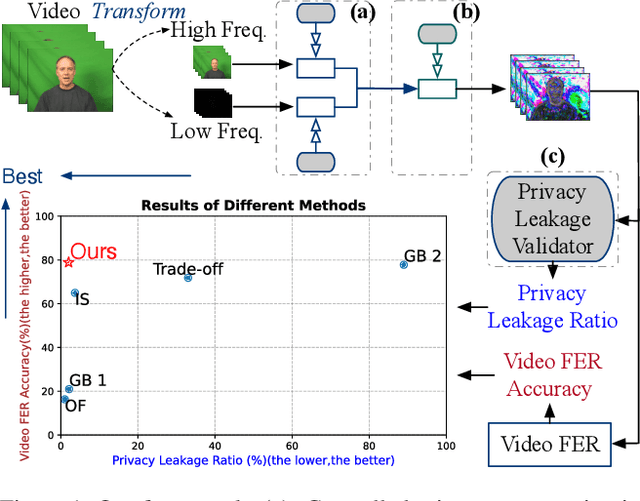
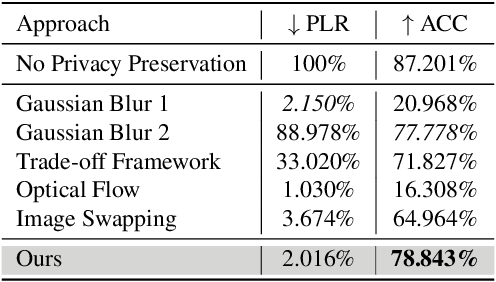


Abstract:Facial expression recognition (FER) systems raise significant privacy concerns due to the potential exposure of sensitive identity information. This paper presents a study on removing identity information while preserving FER capabilities. Drawing on the observation that low-frequency components predominantly contain identity information and high-frequency components capture expression, we propose a novel two-stream framework that applies privacy enhancement to each component separately. We introduce a controlled privacy enhancement mechanism to optimize performance and a feature compensator to enhance task-relevant features without compromising privacy. Furthermore, we propose a novel privacy-utility trade-off, providing a quantifiable measure of privacy preservation efficacy in closed-set FER tasks. Extensive experiments on the benchmark CREMA-D dataset demonstrate that our framework achieves 78.84% recognition accuracy with a privacy (facial identity) leakage ratio of only 2.01%, highlighting its potential for secure and reliable video-based FER applications.
NeFF-BioNet: Crop Biomass Prediction from Point Cloud to Drone Imagery
Oct 30, 2024Abstract:Crop biomass offers crucial insights into plant health and yield, making it essential for crop science, farming systems, and agricultural research. However, current measurement methods, which are labor-intensive, destructive, and imprecise, hinder large-scale quantification of this trait. To address this limitation, we present a biomass prediction network (BioNet), designed for adaptation across different data modalities, including point clouds and drone imagery. Our BioNet, utilizing a sparse 3D convolutional neural network (CNN) and a transformer-based prediction module, processes point clouds and other 3D data representations to predict biomass. To further extend BioNet for drone imagery, we integrate a neural feature field (NeFF) module, enabling 3D structure reconstruction and the transformation of 2D semantic features from vision foundation models into the corresponding 3D surfaces. For the point cloud modality, BioNet demonstrates superior performance on two public datasets, with an approximate 6.1% relative improvement (RI) over the state-of-the-art. In the RGB image modality, the combination of BioNet and NeFF achieves a 7.9% RI. Additionally, the NeFF-based approach utilizes inexpensive, portable drone-mounted cameras, providing a scalable solution for large field applications.
MMCBE: Multi-modality Dataset for Crop Biomass Estimation and Beyond
Apr 17, 2024Abstract:Crop biomass, a critical indicator of plant growth, health, and productivity, is invaluable for crop breeding programs and agronomic research. However, the accurate and scalable quantification of crop biomass remains inaccessible due to limitations in existing measurement methods. One of the obstacles impeding the advancement of current crop biomass prediction methodologies is the scarcity of publicly available datasets. Addressing this gap, we introduce a new dataset in this domain, i.e. Multi-modality dataset for crop biomass estimation (MMCBE). Comprising 216 sets of multi-view drone images, coupled with LiDAR point clouds, and hand-labelled ground truth, MMCBE represents the first multi-modality one in the field. This dataset aims to establish benchmark methods for crop biomass quantification and foster the development of vision-based approaches. We have rigorously evaluated state-of-the-art crop biomass estimation methods using MMCBE and ventured into additional potential applications, such as 3D crop reconstruction from drone imagery and novel-view rendering. With this publication, we are making our comprehensive dataset available to the broader community.
Orientation-conditioned Facial Texture Mapping for Video-based Facial Remote Photoplethysmography Estimation
Apr 16, 2024


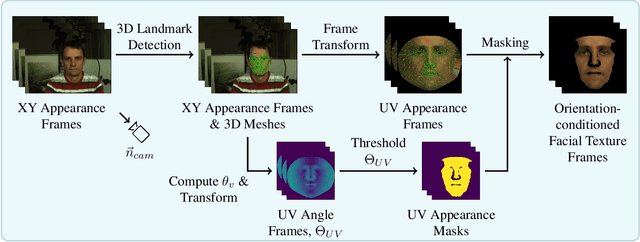
Abstract:Camera-based remote photoplethysmography (rPPG) enables contactless measurement of important physiological signals such as pulse rate (PR). However, dynamic and unconstrained subject motion introduces significant variability into the facial appearance in video, confounding the ability of video-based methods to accurately extract the rPPG signal. In this study, we leverage the 3D facial surface to construct a novel orientation-conditioned facial texture video representation which improves the motion robustness of existing video-based facial rPPG estimation methods. Our proposed method achieves a significant 18.2% performance improvement in cross-dataset testing on MMPD over our baseline using the PhysNet model trained on PURE, highlighting the efficacy and generalization benefits of our designed video representation. We demonstrate significant performance improvements of up to 29.6% in all tested motion scenarios in cross-dataset testing on MMPD, even in the presence of dynamic and unconstrained subject motion, emphasizing the benefits of disentangling motion through modeling the 3D facial surface for motion robust facial rPPG estimation. We validate the efficacy of our design decisions and the impact of different video processing steps through an ablation study. Our findings illustrate the potential strengths of exploiting the 3D facial surface as a general strategy for addressing dynamic and unconstrained subject motion in videos. The code is available at https://samcantrill.github.io/orientation-uv-rppg/.
 Add to Chrome
Add to Chrome Add to Firefox
Add to Firefox Add to Edge
Add to Edge